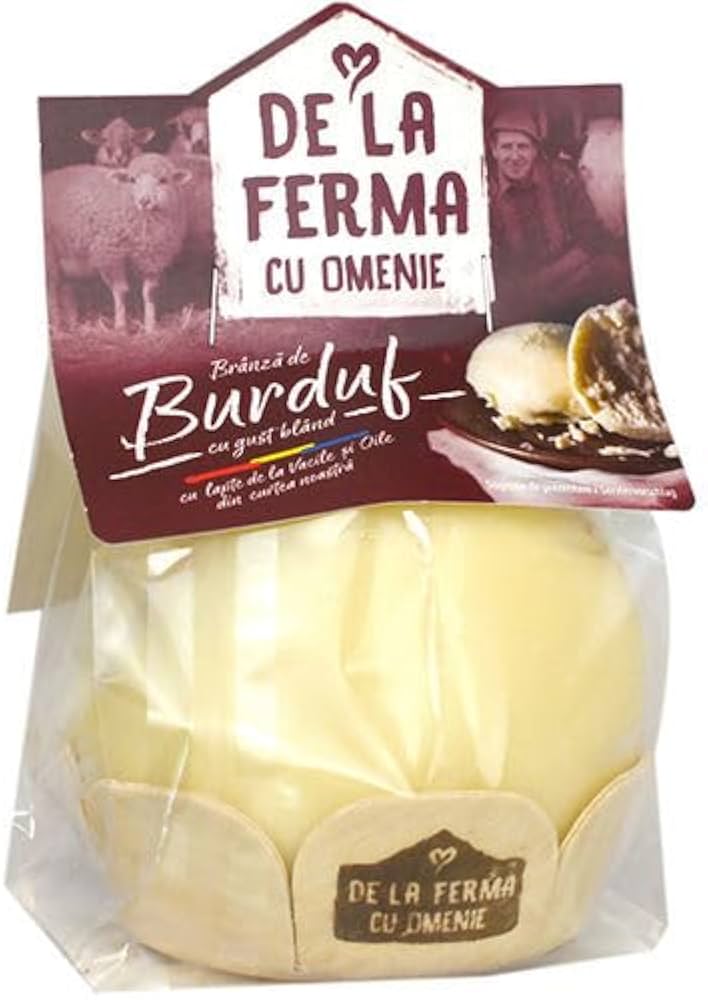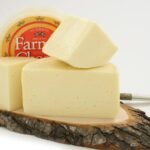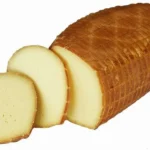Famed for its distinctive texture, rich flavor, and rustic authenticity, Brânza de Burduf cheese is a traditional Romanian delicacy that has been gaining international recognition. Made from sheep’s milk, this cheese is characterized by a slightly salty taste and a creamy, buttery texture. Its production follows an age-old recipe, with methods passed down through generations, encouraging a connection between consumers and Romania’s pastoral heritage.
Production of Brânza de Burduf involves a meticulous process, borrowing heavily from traditional cheese-making practices. The milk used in its preparation is collected from free-grazing sheep, raised on the lush greens of the Carpathian mountains. For the preparation of one kilogram of cheese, around four to five liters of fresh sheep’s milk is required. The milk is coagulated, drained, and then curdled through a process called “cheese breaking”. The curd is repeatedly kneaded and pressed to obtain the cheese core, known as “urdă”. This core is then finely chopped, salted, and hand-mixed before being packed into fir bark, which gives Brânza de Burduf its signature cone or cylinder shape.
- Appearance: Its outer layer is often stained dark brown, thanks to the protective layer of the fir bark. Inside, the cheese is pale, with a texture ranging from pasty in fresh samples to almost solid in well-ripened ones.
- Flavor: The taste of Brânza de Burduf can be intense, enriching, or even slightly sharp depend on the aging period. Its smokey and resinous tones imparted by the fir bark, the slight saltiness, and the rich creaminess dominant the palate.
- Pairing: This cheese is often served with round loaves of crusty bread and a glass of robust Romanian red wine, making it a perfect and inevitable addition to local platters.
Nurtured by the skilled hands of local shepherds and crafted using time-honored techniques, Brânza de Burduf encapsulates the heart and soul of Romanian cheese making. It takes cheese lovers on a gastronomic journey, bringing the undiluted essence of Romanian pastoral culture straight to the table. Every bite of this cheese is a tribute to centuries of tradition, underlining local biodiversity, sustainability, and the incomparable art of Romanian cheesemaking.
Welcome to our short quiz on the topic of ‘Brânza de Burduf cheese from Romania’! This quiz is a cheese lover’s delight, bringing you closer to one of Romania’s most treasured culinary gems. Are you ready to see if you have what it takes to be a real cheese connoisseur? Let’s go!
Unraveling the Unique Qualities of Brânza de Burduf: A Cheese Lover’s Delight from Romania
The world of cheese is filled with a myriad of flavors, thanks to the varying techniques and local nuances from regions across the globe. Among these special delights is Romania’s Brânza de Burduf, a sheep’s milk cheese with a robust flavor profile and distinguishing texture. Beyond its rich taste notes and distinctive texture, there are several characteristics and quality keynotes that set this cheese apart.
Brânza de Burduf, known for its highly creamy consistency and salty taste, is traditionally an artisan product produced in Romania’s Carpathian Mountains. This creamy-white cheese is distinctive in its presentation – pyramid or cylindrical shaped, it’s often covered in fir or pine bark for naturally infusing it with a unique tart, smoky flavor during its maturation process. What stands out about this cheese is its two-layer structure; the inward layer being softer and sweeter, which gradually develops into a stronger, saltier outer layer. This dual-texture is a result of a distinctive processing method where the small cheese curds are manually pressed into a cheesecloth then merged once they reach a certain hardness.
When watching for quality in Brânza de Burduf, note these aspects:
- Texture: It should be soft and elastic. The inner core will be slightly softer and buttery compared to the outer layer.
- Color: A good Brânza de Burduf will be creamy white, with no signs of discoloration or mold.
- Aroma: This cheese should have a distinctive, somewhat strong smell. An absence of aroma may indicate an inferior quality.
- Taste: The flavor should be predominantly salty, but with a lactic, slightly sweet undertone. The presence of an overly bitter taste may indicate improper cleaning or pressing of the curds.
In essence, Brânza de Burduf offers a complex and unique taste experience apt for any cheese aficionado. Its exotic play of flavors and texture surely guarantee its place in the canon of gourmet cheese. Embrace an authentic taste of Romania’s cheese culture and find the quality that makes this cheese a delight like no other.
Unveiling the Intricacies of Brânza de Burduf Cheese from Romania
Brânza de Burduf, a distinguished cheese hailing from Romania, is a crowning gem in the treasure trove of European cheeses. This sheep’s milk cheese’s traditional craftsmanship is entrenched in the Carpathian mountains’ pastoral lifestyle. The exquisite, slightly tangy flavor and creamy texture are the drums beating in praise for its popularity amid gastronomes. Let’s delve into the intriguing story of its unique ingredients, properties, and multifarious variants.
The cheese-making process of Brânza de Burduf sets it apart from its cheese counterparts globally. Its production begins with a selection of high-quality sheep’s milk, preferably locally sourced from Romanian sheep grazing on the plentiful Carpathian mountain herbs. The milk is then put to curdle by introducing traditional rennet, turning it into cheese curds. These curds are separately heated, and the whey thus obtained is left aside for fermentation over multiple days. Simultaneously, the solid curd is cut, salted, and allowed to drain. After sufficient fermentation, the curd is kneaded into a homogeneous paste and stuffed into a sheep’s stomach, or traditionally, the skin of a pine bark, providing Brânza de Burduf its characteristic flavor and supple, creamy texture. This method represents the essential genius of Romanian shepherds, a tradition carried down over generations.
The Brânza de Burduf cheese, despite its generic name, comes in various regional iterations, based on the peculiarities of their manufacturing process and local idiosyncrasies. The variances come in numerous ways, such as the specific breed of sheep, grazing habits, chosen curdling agent, aging period, and the fermenting container’s material. Each variation lends a unique characteristic to the cheese, contributing to a wide range of flavors, from mildly tangy to significantly piquant. Among the notable variants are Telemea and Cașcaval, each with their own story to tell.

- ‘Telemea’ is a milder variant obtained from cow or sheep milk, soaked in brine to elevate its taste. Lightly acidic and slightly crumbly, it’s a favorite choice for salads and traditional Romanian dishes.
- ‘Cașcaval’ lends itself to a smoky flavor, which comes from sheep or cow milk or a blend of both. Its semi-hard texture makes it ideal for grilling and frying purposes, a gorgeous golden crust adding an appealing visual, and sensual delight.
Brânza de Burduf is not just a cheese; it’s a rich tapestry, each thread representing the cultural nuances of the region from which it originates. Its intriguing process of preparation, varied versions each with its distinctive character have etched it a prime position in the hierarchy of cheese aficionados. A cheese so exquisite in taste, so teeming with heritage, and so beautifully nuanced – is worth savoring ad infinitum.
- The production of Brânza de Burduf involves a two step process that includes curdling and maturing the cheese.
- Due to the unique aging process, Brânza de Burduf develops an interesting yellowish-grey outer crust.
- Brânza de Burduf received its PDO status back in 2009.
- Typically, Brânza de Burduf is eaten in salads, on bread, or simply by itself.
- This cheese is from the southern regions of Romania and is deeply embedded in the traditional Romanian diet.
- The term “burduf” in Brânza de Burduf actually means “sheep’s stomach” in Romanian.
- Brânza de Burduf is often consumed in Romania during the winter holidays as part of traditional dishes.
Explore the Rich Heritage of Brânza de Burduf Cheese from Romania
The famed Brânza de Burduf cheese, native to the stunning landscapes of Romania, presents a unique gastronomy delight to cheese lovers. Here, we delve into the exquisite subtleties that the locality brings to this mouth-watering treasure. The topography and climatic conditions of Romania, specifically the Carpathian mountains, contribute to the distinct taste and texture of Brânza de Burduf cheese, which is unparalleled in its complex aromatic profile.
Brânza de Burduf cheese is a traditional Romanian cheese made from sheep’s milk. A prolonged maturation period, involving careful methods of kneading and salting, takes place in pine bark casings within a specialized chamber. These wooden encasings afford a unique aroma to the cheese which is intricately interwoven with the sharp and tangy flavor characteristics of the sheep’s milk. Its production is not only grounded in the regions of Transylvania, Bucovina, and Maramureș but is deeply intertwined with the cultural heritage and the pastoral traditions of these lands. The seasonal herding habits of the local shepherds, the rich floral variety of the Carpathian mountains, and the traditional production methods all contribute to the singular taste and quality of this cheese.
The taste of Brânza de Burduf cheese is a delightful experience, with a pronounced salty and tangy flavor, complemented by creamy and buttery textures underlying the rich sheep’s milk content. The unique maturation process renders a slight bitterness that further elevates the punchy taste. These taste notes are representative of the specific conditions in which the cheese is born and matured. With a creamy paste-like consistency, the cheese pays tribute to the long-established cheese-making customs in the heart of Romania.
- Region of Production: Transylvania, Bucovina, Maramureș
- Milk Type: Sheep’s Milk
- Aging Period: Extended Maturation in Pine Bark Casing
- Taste: Salty, Tangy with a Slight Bitterness, Creamy and Buttery Texture
A deep dive into the story and tradition of Brânza de Burduf is an exploration of centuries-old artistry in cheese-making. It is a symphony of tradition, culture, environment, and craftsmanship, all narrated through the language of taste. One bite into this cheese, and you taste Romania – its lands, its climate, its heritage, and its undying love for cheese.
Delighting in the Distinctive Taste of Brânza de Burduf, Romania’s Traditional Cheese
Brânza de Burduf, a traditional sheep’s cheese from Romania, is truly a gastronomic treasure. Its tangy, slightly salty flavor is unmatched and is a direct product of its distinctive production process. It’s been said that no visit to Romania is complete without trying this unique cheese, and for good reason. But the enjoyment of Brânza de Burduf isn’t limited to one’s visit to Romania; the intriguing taste can be carried back in memories and shared with those who love exploring global flavors. Experienced cheese connoisseurs differ in their eating habits, but everyone agrees – Brânza de burduf is best enjoyed fresh.
Brânza de Burduf is traditionally handmade in the Carpathian Mountains of Romania. Each wheel, often weighing between 1-2 kg, is carefully crafted by wrapping curds in fir bark or pine needles, a labor-intensive process that contributes to the cheese’s unique flavor profile. This technique also gives the cheese a distinctive cylindrical shape, with a soft, creamy texture inside owing to the high-fat content of sheep’s milk used.
So, how should you enjoy this Romanian delicacy? Here are some expert recommendations on savoring Brânza de Burduf:
- Dine Al Fresco: This potent, flavor-packed cheese shines in an outdoor setting. Enjoy slices on a warm, crusty bread with a glass of Romanian wine, under the open sky.
- Pair with Fruit: The sharp, tangy flavor of Brânza de Burduf contrasts brilliantly with the sweetness of fruit. Pair it with thinly sliced apples, grapes, or even figs for a delightfully balanced tasting experience.
- As a Topping or Filling: In Romania, it’s very common to find Brânza de Burduf used as a garnish or filling in various dishes, such as meat stews and some types of pastries, enhancing the complexity of the meal. Its creaminess blends surprisingly well with hearty, savoury dishes.
Whether you’re a seasoned cheese aficionado or a casual foodie looking for a new discovery, Brânza de Burduf offers a unique, indulgent experience. It’s a cheese that sings of its place of origin, and one that invites imaginative culinary exploration.
Mastering the Art of Storing Brânza de Burduf, the Romanian Cheese Delicacy
The world of cheese is as varied as it is wonderful, with each country offering its unique type. One such specialty you must try is Brânza de Burduf, a traditional cheese from Romania. Renowned for its rich taste and unique method of preparation, this cheese is a delicacy but can be quite tricky to store properly. As an expert cheesemonger, understanding the right way to store Brânza de Burduf can ensure that you’re able to enjoy its distinct flavor at its peak.
Brânza de Burduf is a soft, salty cheese made from sheep’s milk. Traditionally, this cheese is stored in fir bark, which not only protects the cheese but also enhances its flavor with a resinous tang. However, if you aren’t equipped with fir bark, modern preservation methods can do the job. Storing Brânza de Burduf in a cheese cave or a dedicated article of your refrigerator can be quite effective, maintaining optimal conditions of about 4 to 8 degrees Celsius with relative humidity of 80-85%. The cheese should be wrapped carefully in waxpaper or cheesecloth to avoid excessive drying out. Regularly flipping the cheese is important to prevent over-maturation on one side.
While these tips apply for unopened Brânza de Burduf, storing once it’s been cut requires a bit more care. Store slices of Brânza de Burduf in aluminium foil or a reusable wax wrap to keep it active, and consume within ten days to avoid loss in freshness and taste. Always remember to smell your cheese before eating. Fresh Brânza de Burduf should smell milky with a hint of that familiar resinous tang. Any off or excessive odor is an indication that all is not well.
- Optimal Storage Conditions: 4 to 8 degrees Celsius with 80-85% relative humidity.
- Suitable Wraps: Waxpaper or Cheesecloth.
- Freshness Indication: Milky smell with a resinous tang.
And there you have it. Storing Brânza de Burduf is an art indeed. Mastering these steps will enable you to savor your cheese for longer periods, elevating your gastronomic experiences while reducing food waste. Remember, good cheese is about quality and proper handling. Enjoy your Brânza de Burduf!
Discovering the Perfect Wine for Brânza de Burduf, Romania’s Pride
Brânza de Burduf is a unique sheep’s milk cheese hailing from the Carpathian Mountains of Romania. An epitome of traditional Romanian cheese, it is carefully crafted by hand, traditionally presented in a fir bark casing, and boasts a powerful, robust flavor. Whether you are a cheese enthusiast or a seasoned gourmand, pairing the right wine with Brânza de Bur-duf could be an indulgent culinary adventure, accentuating the savoriness of this artisanal cheese.
One thing to remember when pairing wines with robust cheeses like Brânza de Burduf is to not let the wine overpower the cheese’s personality or vice versa. You would need a wine that can stand up to the cheese’s full, intense, and slightly salty taste. Excellent matches for Brânza de Burduf are medium to full-bodied white wines such as a rich, buttery Chardonnay from California, or a vibrant, fruity, and aromatic Viognier from Rhône Valley. These wines beautifully balance the depth of flavor and texture of the cheese while adding their own distinctive notes to the palate. If you lean towards reds, a Pinot Noir or a Merlot with its soft red fruit notes and moderate acidity could tango beautifully with this strong cheese.
For those who fancy sweet wines, a Sauternes with its balanced acidity can cut through the richness of the aged Brânza de Burduf and leave a refreshing taste. A glass of fortified wine such as a Port or Sherry might also make an interesting choice. Their concentrated flavors and higher alcohol content can match the intensity of this fabled Romanian cheese. Just follow these pointers:
- White Wine: Opt for a Californian Chardonnay or a Rhône Valley Viognier
- Red Wine: Choose a Pinot Noir or a Merlot
- Sweet or fortified Wine: Go for a Sauternes, a Port, or Sherry
In conclusion, the perfect wine pairing can transform your Brânza de Burduf experience from delicious to sublime. A word of advice though, the best match often depends on personal preference. So, try different combinations and savor the ones that make your palate sing.
Discovering Delightful Pairings for Brânza de Burduf, Romania’s Cheese Gem
Exquisitely rich and savory, Brânza de Burduf stands as a distinctive gem in Romania’s culinary scene. This cheese has a unique, ball-like shape, a characteristic that stems from its traditional preparation method where it’s stored in a sheep’s stomach or in pine bark tubes. This unique storage practice adds a strong, tangy flavor to the cheese, further amplified by its high fat content. While Brânza de Burduf significantly boasts immense flavor itself, the question begs of what kinds of food can heighten its native flavor?
The robust and salty flavor of Brânza de Burduf can be offset by sweet or mildly flavored foods. Romanian tradition often aligns this cheese with ‘Mămăligă’, a cornmeal porridge similar to polenta. The creaminess of the Mămăligă complements Brânza de Burduf’s intense flavor. Additionally, fresh seasonal fruits such as pears, raisins, figs, and apples make excellent companions to this cheese. The sweetness of these fruits forms a beautiful contrast to the saltiness of Brânza de Burduf.
- Mămăligă: A creamy porridge that balances the saltiness of the cheese.
- Pears: Brânza de Burduf pairs well with pears due to their crisp texture and sweet flavor that tames its robust flavor.
- Raisins: Offer a sweet chewy contrast to the cheese’s intense flavor.
- Figs: Their sweet and pulpy texture makes for an excellent pairing with this Romanian cheese.
- Apples: Pairing this cheese with apples adds a crispy and refreshing contrast to the creamy and pungent flavor of Brânza de Burduf.
Next time you set out to create a unique, exotic cheese plate or looking to explore Romanian cuisine, consider Brânza de Burduf. Whether it’s savored with traditional Mămăligă or served alongside sweet fruits, this Romanian cheese gem promises a unique gastronomic experience full of contrast and harmony. Explore and enjoy the game of flavors with Brânza de Burduf and its savory pairings.
Discovering the Heritage and Ceremonial Excellence of Brânza de Burduf Cheese from Romania
The Brânza de Burduf cheese stands as a timeless testament to the scrumptiousness of traditionally made cheese, cherished in Romania for centuries. Imagined and recreated in the highest pastures around Transylvanian mountains, Brânza de Burduf is not only a tribute to the Romanian field’s fecundity but also a reflection of their inherent cheesemaking finesse. Imbued with a strong aroma and slightly tangy, salty flavour, it is primarily made from sheep milk. But sometimes a mixture of cow and sheep milk is used, depending on the period of production and local traditions.
The making of Brânza de Burduf is a painstaking and meticulous process. Noted for its characteristic shape, the cheese, once processed, is packed into a casing of pine bark known as ‘vezica,’ a process that requires practiced hands and lends the cheese its distinctive flavour. Once encased, it’s left to mature for up to three weeks to allow its distinctive palatal feel and taste to develop fully.
- Firstly, sheep milk is boiled and then left to cool to around 32-35°C. Then a starter culture of fermented whey from previous cheese production is introduced to ferment the milk.
- After a lengthy fermentation process, the created cheese mass is cut and drained before being manually kneaded and salted.
- The cheese is then shaped into balls of approximately 1-2 kg each which are put in sheep stomachs or sheepskin, sometimes even fir wood bark to ripen which can take up to a few weeks.
The historical importance of Brânza de Burduf to the Romanian people is deeply etched in their folktraditions. Apart from occupying an essential place in their everyday meals, it continues to play a significant role in celebrating local holidays and events- from the hay harvesting festival to the rustic weddings. So next time you are exploring the delicacies of Romania, don’t forget to sample this traditional mouth-watering delight, a piece of cheese history preserved over centuries.
A Deep Dive Into Brânza de Burduf Cheese and Similar Varieties
Known for its rich flavor and exceptional texture, Brânza de Burduf is a unique cheese from Romania, highly prized for its distinct qualities. However, exploring similar cheeses can lead to an enlivening culinary journey that broadens the palette and unveils the expansive world of cheese. Named after the Romanian word for ‘barrel’, Brânza de Burduf is traditionally handmade by experts and shaped into a characteristic sphere.
One such cheese that closely mirrors Brânza de Burduf is Feta, a Greek curd cheese. Both are made predominantly from sheep’s milk and boast a tangy, sharp flavor that is both savory and slightly sour. The texture is another commonality, with their soft yet crumbly texture making them an excellent choice for salads. Yet, Feta tends to be slightly softer and tangier when compared to Brânza de Burduf.
- Casu Marzu: Originating from Sardinia, this sheep milk cheese is similar to Brânza de Burduf in terms of its strong flavor. Known for its peculiar preparation method involving live insect larvae, Casu Marzu boasts a bold flavor, similar to Gorgonzola.
- Roquefort: A French cheese, made of ewe’s milk, Roquefort shares a similar soft and slightly crumbly texture to its Romanian counterpart. This strong, tangy cheese is also known for its pronounced sharp, astringent flavor which will charm fans of Brânza de Burduf.
To conclude, these similar varieties hold up a mirror to Brânza de Burduf, each revealing facets of the latter’s nature. Although each cheese mentioned here has its own unique qualities, the similarities they share with Brânza de Burduf are undeniable, making them worth exploring for every cheese lover. Whether it’s the boldness of Casu Marzu or the astringent touch of Roquefort, each offers a new perspective on the spectrum of flavors and textures found in sheep’s milk cheese like Brânza de Burduf.



